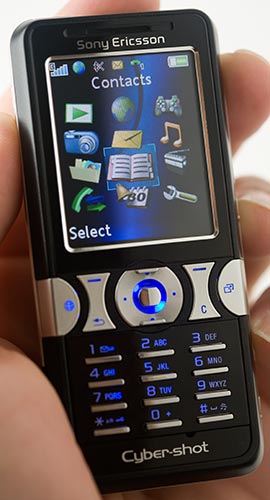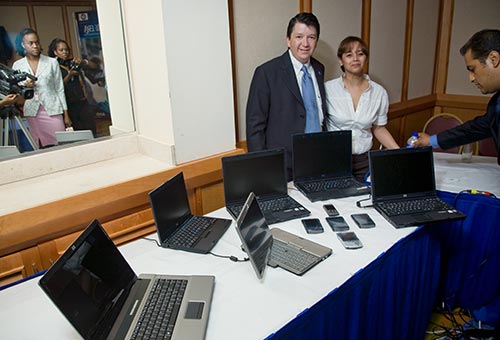BitDepth 591 - August 28
07/01/09 19:24 Filed in: BitDepth - August 2007
Every now and then I get to play with the shiny toys. Some thoughts on Sony's new line of mobile phones and HP's refreshed line of laptops.
Sony raises the stakes with new phones

Sony Ericsson's K550 Cybershot phone in menu mode, showing big readable icons. But no touchscreen here. Photo by Mark Lyndersay.
Sony Ericsson recently introduced a new line of cell phones to the market at a stylish event at 51 degrees. The company's local representatives rolled out a red carpet and provided its own swarm of paparazzi to pop flashes at arriving guests for an event that showcased a line of sleek, silver accented mobile handsets.
The line is segmented into broad markets "Easy Communication" or affordable, "Walkman" offering enhanced music playback capabilities, "Cybershot" featuring two to three megapixel cameras and a useless digital zoom and "Web," the company's top of the line smart phones.
Because of the competitive market for mobile phone sales, Sony's local representatives could not say which phones were going to be offered by bMobile or Digicel, but the company will not be providing unlocked models for the market.
bMobile is currently offering the W200 and K550 and both providers have chosen models from the line to offer through their distributors.
I've had the opportunity to test the K550, an impressive black and silver number that feels like a slightly chunky Krzr phone but packs a host of top of the line features into a slim case.
The traditional Sony Ericsson interface, running on Sony's brand of Java has been spiffed up bit with bright, colourful icons that are refreshingly large.
You get access to most common features with a single click of the menu button, and it's just a bit of navigation from there to addresses, web browsing, music and connectivity features. Power users can assign shortcuts to the functions they will use most often.
Putting the mobile to work
Getting the phone to communicate with my MacBook was a little trickier, but I've been down this road before. Apple provides a framework for synchronising with most phones but is notoriously tardy in providing updates. Happily, a German company called Novamedia will normally have a plug-in ready for your new phone.
Once connected, I had access to almost everything the phone is capable of, which includes some useful capabilities that I'll elaborate on next week. I was able to transfer contacts and appointments without a hitch and access both the phone's built in memory and memory card, which makes it easy to pull pictures captured with the camera or push MP3 files to the built-in player.
The contacts display is a bit odd, requiring you to left and right navigate to get to alternate numbers, which hits the one recurring weakness of the K550, a navigation wheel that's so tiny that I had to use a thumbnail to push the right spot on the brushed metal ring.
The entire line is elegant, with silvery shells and in the premium lines black cases studded with silver accents. The "emotional" range gets a little wild and girlish, but I'm not the target for that line. The Java OS is responsive, colourful and bright, and despite the richness of the functions, doesn't unnecessarily deplete talk or standby time.
The sweet spot of the line is the K series, which offers most of the connectivity of the high-end offerings. If you need the Symbian OS for a third party software solution, you'll need to look at the M600 and P990.

HP's Solutions Manager, Personal Systems Group for the Caribbean, Ted Serrano (at centre) gets ready to show off his company's new lineup for the press. Photo by Mark Lyndersay.
Does HP get it?
Two weeks ago, I visited the Hilton for a launch of HP's new line of business notebooks and a new smart phone.
The portables are standard business fare, black plastic shells with current Intel and AMD processors, with cases that look more like Lenovo/IBM sober business black designs than anything that HP has offered before.
There are some useful innovations focused on hard core business professionals, including QuickLook, which offers a glance at basic information without booting up the system, fast charging batteries that get to 70 percent of capacity in 90 minutes and sleek, light external batteries that clip neatly onto the notebooks and more than double battery runtimes.
What seemed to be missing was a coherent plan for penetrating the local market. HP's Ted Serrano, Solutions Manager for the Caribbean was focused on traditional methods of sales, emphasising "the channel" the authorised providers who would be selling business systems and consumer systems.
Now authorised representatives and support centres with rooms full of parts are a crucial thing to have when you're doing business in a country, but ignoring the massive flow of systems that arrive each day in the country on palettes from the US just seems short-sighted to me.
This sort of corporate cluelessness isn't uncommon. Apple, who make the computers I've used for the last 17 years, has no idea what to do with its markets south of the Florida Keys.
The difference here is that HP is going to be in a battle for market share with Dell, who do "get it" and have become a dominating presence in the local market by addressing both traditional, US standard sales channels and by courting the small businesses, professionals and savvy consumers who want to cherry pick the right solutions and buy them online.

Sony Ericsson's K550 Cybershot phone in menu mode, showing big readable icons. But no touchscreen here. Photo by Mark Lyndersay.
Sony Ericsson recently introduced a new line of cell phones to the market at a stylish event at 51 degrees. The company's local representatives rolled out a red carpet and provided its own swarm of paparazzi to pop flashes at arriving guests for an event that showcased a line of sleek, silver accented mobile handsets.
The line is segmented into broad markets "Easy Communication" or affordable, "Walkman" offering enhanced music playback capabilities, "Cybershot" featuring two to three megapixel cameras and a useless digital zoom and "Web," the company's top of the line smart phones.
Because of the competitive market for mobile phone sales, Sony's local representatives could not say which phones were going to be offered by bMobile or Digicel, but the company will not be providing unlocked models for the market.
bMobile is currently offering the W200 and K550 and both providers have chosen models from the line to offer through their distributors.
I've had the opportunity to test the K550, an impressive black and silver number that feels like a slightly chunky Krzr phone but packs a host of top of the line features into a slim case.
The traditional Sony Ericsson interface, running on Sony's brand of Java has been spiffed up bit with bright, colourful icons that are refreshingly large.
You get access to most common features with a single click of the menu button, and it's just a bit of navigation from there to addresses, web browsing, music and connectivity features. Power users can assign shortcuts to the functions they will use most often.
Putting the mobile to work
Getting the phone to communicate with my MacBook was a little trickier, but I've been down this road before. Apple provides a framework for synchronising with most phones but is notoriously tardy in providing updates. Happily, a German company called Novamedia will normally have a plug-in ready for your new phone.
Once connected, I had access to almost everything the phone is capable of, which includes some useful capabilities that I'll elaborate on next week. I was able to transfer contacts and appointments without a hitch and access both the phone's built in memory and memory card, which makes it easy to pull pictures captured with the camera or push MP3 files to the built-in player.
The contacts display is a bit odd, requiring you to left and right navigate to get to alternate numbers, which hits the one recurring weakness of the K550, a navigation wheel that's so tiny that I had to use a thumbnail to push the right spot on the brushed metal ring.
The entire line is elegant, with silvery shells and in the premium lines black cases studded with silver accents. The "emotional" range gets a little wild and girlish, but I'm not the target for that line. The Java OS is responsive, colourful and bright, and despite the richness of the functions, doesn't unnecessarily deplete talk or standby time.
The sweet spot of the line is the K series, which offers most of the connectivity of the high-end offerings. If you need the Symbian OS for a third party software solution, you'll need to look at the M600 and P990.

HP's Solutions Manager, Personal Systems Group for the Caribbean, Ted Serrano (at centre) gets ready to show off his company's new lineup for the press. Photo by Mark Lyndersay.
Does HP get it?
Two weeks ago, I visited the Hilton for a launch of HP's new line of business notebooks and a new smart phone.
The portables are standard business fare, black plastic shells with current Intel and AMD processors, with cases that look more like Lenovo/IBM sober business black designs than anything that HP has offered before.
There are some useful innovations focused on hard core business professionals, including QuickLook, which offers a glance at basic information without booting up the system, fast charging batteries that get to 70 percent of capacity in 90 minutes and sleek, light external batteries that clip neatly onto the notebooks and more than double battery runtimes.
What seemed to be missing was a coherent plan for penetrating the local market. HP's Ted Serrano, Solutions Manager for the Caribbean was focused on traditional methods of sales, emphasising "the channel" the authorised providers who would be selling business systems and consumer systems.
Now authorised representatives and support centres with rooms full of parts are a crucial thing to have when you're doing business in a country, but ignoring the massive flow of systems that arrive each day in the country on palettes from the US just seems short-sighted to me.
This sort of corporate cluelessness isn't uncommon. Apple, who make the computers I've used for the last 17 years, has no idea what to do with its markets south of the Florida Keys.
The difference here is that HP is going to be in a battle for market share with Dell, who do "get it" and have become a dominating presence in the local market by addressing both traditional, US standard sales channels and by courting the small businesses, professionals and savvy consumers who want to cherry pick the right solutions and buy them online.
blog comments powered by Disqus

